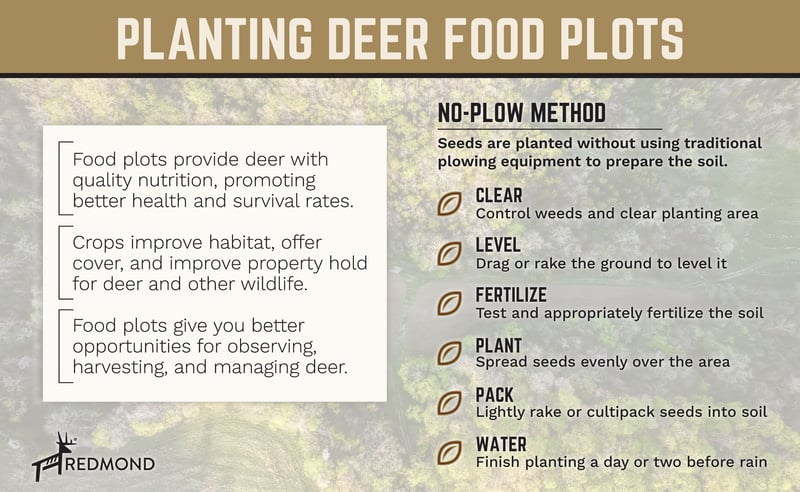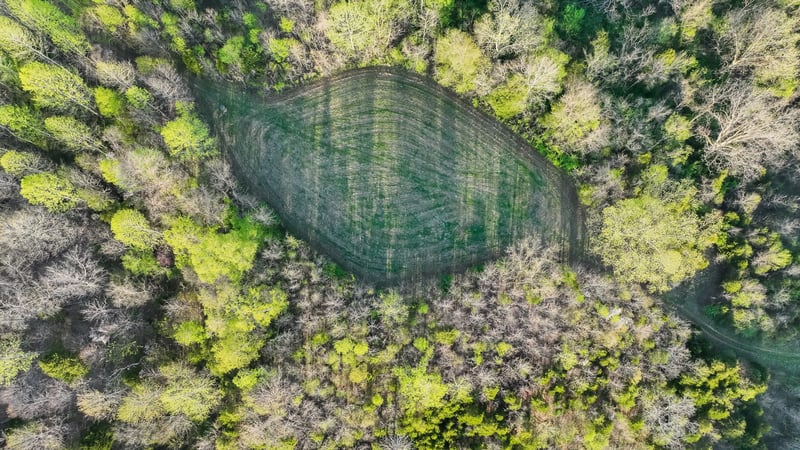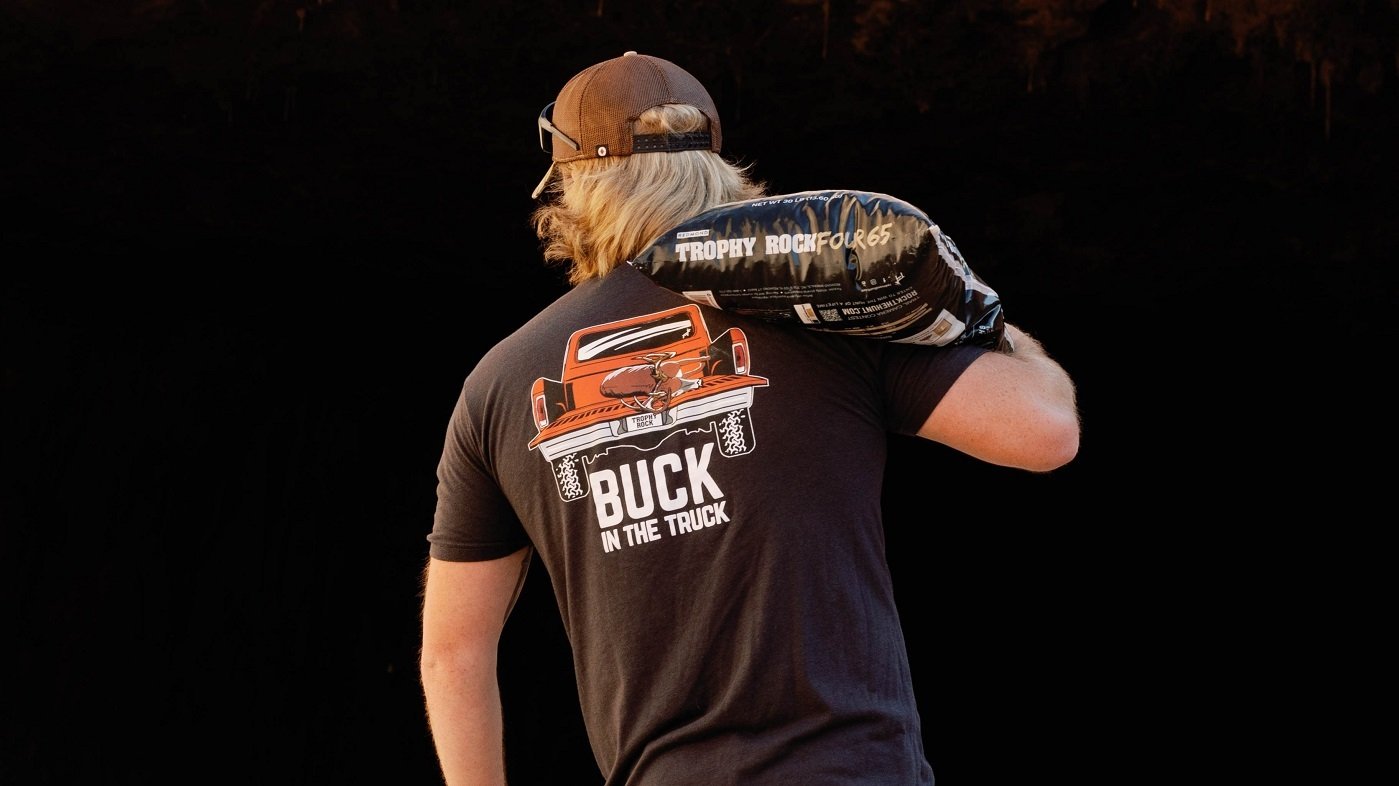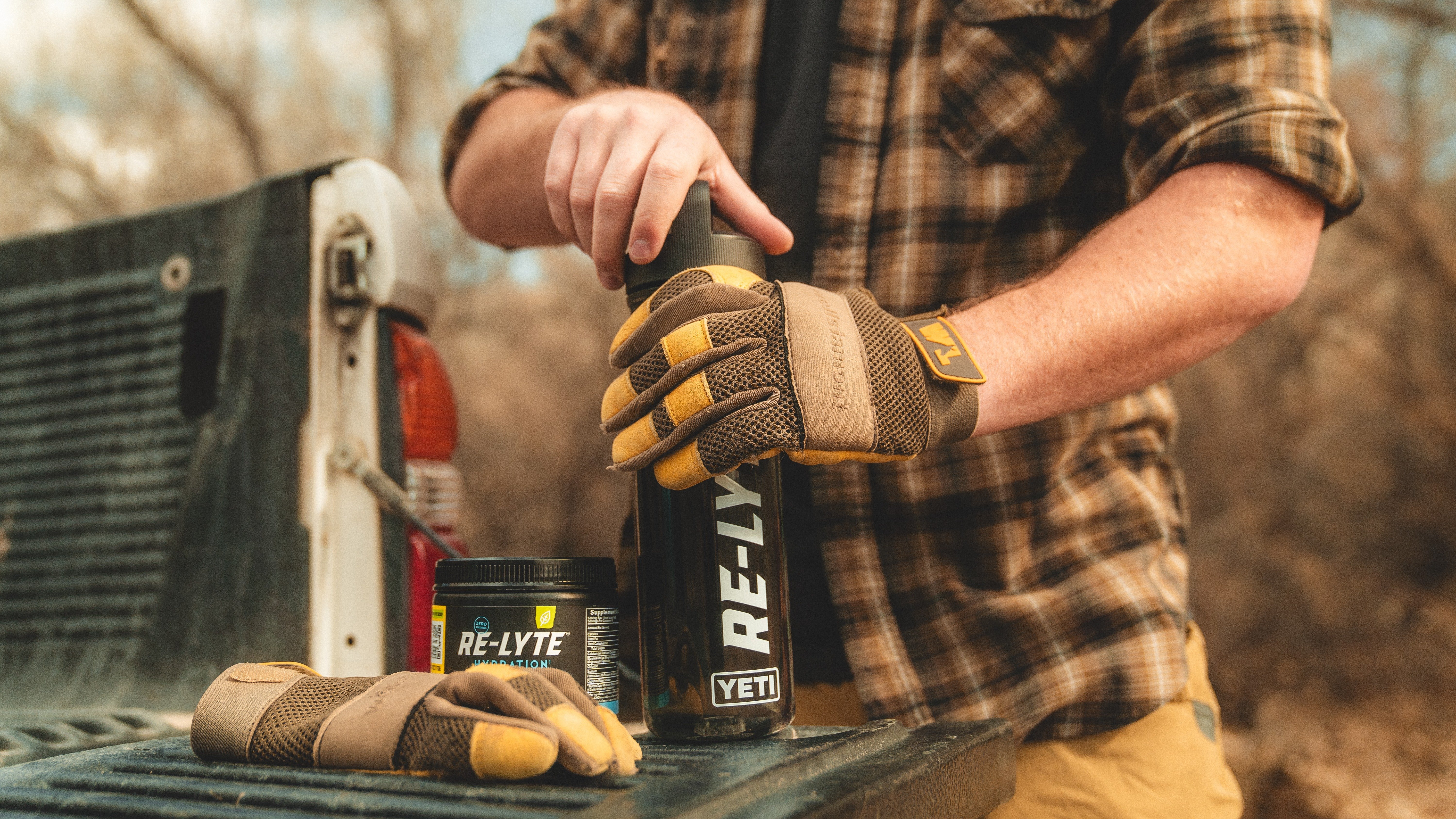Redmond Hunt Blog
Land Managers Share the Dirt on Planting Deer Food Plots
Redmond Hunt April 25, 2024
Get expert tips from Redmond team members on planting deer food plots, including seeding, fertilizer use, and more using both no-till and plowing methods.
Planting food plots on private lands can be a boon for deer herds and the hunters managing them. If you have hunting property and some small equipment, you can turn a few acres into prime feeding grounds for deer. And for those with access to larger machinery, the possibilities expand exponentially.
We tapped two Redmond team members to learn how and what they plant using both till and no-till methods. While you’ll need to decide what works best for your property and budget, these suggestions can give you a starting point. Let’s touch on the benefits of food plots before digging into some planting FAQs.
Why Investing in Food Plots Pays Off for Both Deer & Hunters
If you like working with the land, managing a herd, and harvesting healthy deer, you’ll likely find the work of food plots rewarding. Isaac Boone, a seasoned hunter and land manager, notes the dividends are well worth the sweat equity spent planting plots.
“The advantages are incredible,” he said. “Food plots help boost the deer population, hold more deer on your property, and make managing them easier and better. You also spend less time baiting, which means less scent and pressure on deer from humans going in and out. Plots are also great for early deer hunting and shed season.”
Here are four more reasons why carving out space for deer crops on your property is worthwhile:
- Quality Nutrition. Plots provide food for deer through fall and winter when native forage is harder to come by, promoting better health and survival rates.
- Herd Management. Cover crops enhance the overall habitat of your property, improving hold for deer and other wildlife.
- Hunting Opportunities. Plots can be strategically placed to attract deer, giving you better opportunities for observing, harvesting, and managing deer.
- Recreational Enjoyment. Planting and maintaining plots help you connect with nature, observe wildlife behavior, and contribute to deer conservation efforts.
Pro Tips for Planting Deer Plot Food
We asked Isaac Boone from Kansas and Kyle Jennings from Ohio questions people often search for when venturing into food plot preparation. Kyle plants on a larger scale using tractor machinery. Isaac utilizes a no-plow approach using small pull-behind or handheld equipment. Check out their responses below.

Q. What are the benefits of seeding food plots using no-till vs. plowing methods?
Kyle: For small 1- to 3-acre plots where you can’t get machinery in, no-till and broadcast is a great option and works really well. They’ve come a long way with attachments for your ATV and UTV. You can still work up the dirt and cultipack seed in without a tractor or breaking the bank.
I started out with no-till plots that worked well, and then was able to get machinery that helped big time. It obviously does a much better job of breaking up the dirt, compacting the seeds into the soil, and getting more seed germination. All farms and land are different, though. Get to know your land and the best options for it.
Isaac: I plant no-plow food plots (aka throw-and-grow food plots) and have had great results, especially with frost-seeding in the spring. This method is much cheaper, less time-consuming, and allows you to cover more plots in less time. It works well for property owners like me working ground on a relatively small scale.
Q. What food plot equipment do you need for no-plow planting?
Isaac: If you’re frost-seeding a plot in early spring, you just need a spreader. For a no-till food plot in later spring or fall, you’ll need a sprayer to kill the existing grass and a mower to cut it down once it’s dead. I like using my box blade spikes (pulled behind either a riding mower or ATV/UTV) to work the ground, and then a drag or rake to flatten everything out before planting. You’ll need a seed spreader of some kind—I prefer a handheld. And a cultipacker is also handy to press the seeds into the soil.
Q. How many acres do you recommend for a deer food plot?
Kyle: Usually, I want at least 5 acres if I’m planting beans or corn. For smaller plots, I really like winter wheat, turnips, brassicas, and radishes.
Isaac: I wouldn’t want anything less than a half-acre. Typically, my plots are between 0.7 to 2 acres. That size range works well to tackle using small-scale equipment like mine.
Q. Where are the best locations for deer food plots?
Isaac: Look for areas with good soil or good growth. For example, bottomlands or near creeks and rivers. Stay away from deer bedding areas and high-traffic locations for humans, like roadsides or houses. Look for flat terrain to prevent erosion and areas that get enough sunlight.
Q. What crops make the best food plots for deer?
Isaac: My favorites are white clover, alfalfa, and turnips. They seem to not only attract the deer the best, but they are the simpler seeds to plant and grow. And most clover and alfalfa are perennial, lasting a solid 4-5 years, which is great on time. Buffalo clover is the perennial I prefer.
Kyle: I plant different things depending on the area and how many acres I’m planting. In areas with small food plots, I like winter wheat and turnips or radishes. For larger areas, clover, corn, and beans.
Corn works amazing for late season, especially if you bush-hog it down. For early planting, I prefer corn and beans. Clover also works extremely well. You’ll want to keep an eye on the height, though; you don’t want it extremely tall. Bush-hogging it when it gets over 10 inches will help it come back healthier and thicker. Maintaining a cut height of about 4-8 inches also helps with weed control.
 An early spring food plot beginning to grow in Ohio.
An early spring food plot beginning to grow in Ohio.
Q. When is the best time to plant deer food plots?
Isaac: For overseeding, shoot for late February or early March when it’s still getting down below freezing. Clover is my favorite crop for spring. Or plant in mid-August for fall turnips and clover.
Kyle: I like to start prepping the fields—spraying, tilling and fertilizing—around April and plant in mid-May for spring crops. My fall plots I’ll plant around July to August. Timing a rain coming in is key. You want a good rain within at least three days after planting, otherwise your fertilizer will start to burn up and won’t work properly.
Q. What is your go-to deer food plot fertilizer?
Kyle: The key to getting the best fertilizer for food plots is a soil test. See what your dirt needs. If you can’t test your soil, use the proper lime and fertilizer. Spreading lime then adding 13-13-13 or 19-19-19 fertilizer at approximately 200 pounds per acre works really well with winter wheat, turnips, and brassicas.
Isaac: Lime and fertilizer are my typical preparation. I use DeerGro Plot Start for the lime replacement; it’s so much easier and works great. For fertilizer, I use my local co-op's 13-13-13 and DeerGro Plot Boost.
Did You Know? Redmond offers a Soil Test Kit that makes testing your soil dirt simple! The customized approach helps you know exactly what your soil needs to thrive so you can grow the healthiest plants possible.
Q. In your experience, what is the best seed for a no-till food plot?
Isaac: I used to use my local co-op seed but recently made the switch to Eagle Seed. The Top Five annual clover blend works great for fast-growing plots. I plant in the spring and the crops are ready to hunt over in the fall. Top Five is also great for frost-seeding in the spring when it’s getting below freezing at night.
Kyle: Some easy growing, good no-plow seeds are also winter wheat, turnips, and brassicas.
Q. Do you still need to provide deer with minerals if you grow food plots?
Kyle: Food plots and mineral sites make a great pair. Deer get all the nutrition they need through minerals and food plots, which is key during the spring and summer months when antlers are growing and does are fawning.
Isaac: Food plots are a great location for mineral sites. I like to have mine on the outskirts of the plot. Minerals and food plots are two of the main stepping stones to healthy herd management and a huge part of my success.
Redmond Product Tip: Redmond Trophy Rock products are a solid addition to any good deer food plot program. Try our rock, block, granular minerals, or liquid supplements. Whether alone or combined, they provide deer with full-spectrum sea minerals that nourish and promote optimal growth and herd health. Click below to shop now.
About the Authors
 Kyle Jennings: I’ve been a hunter my whole life, but as I got older, food plots really caught my attention. I’ve learned a lot about the best areas and when and what to plant. The biggest key to holding deer on a property is proper nutrition through minerals and food plots. You’ll be amazed what deer stay in close range when they have plenty of food to eat.
Kyle Jennings: I’ve been a hunter my whole life, but as I got older, food plots really caught my attention. I’ve learned a lot about the best areas and when and what to plant. The biggest key to holding deer on a property is proper nutrition through minerals and food plots. You’ll be amazed what deer stay in close range when they have plenty of food to eat.
 Isaac Boone: I’ve managed deer herds for 20 years and enjoy continually learning new things about whitetails. Management is much more than cameras, stands, and hunting. It’s mineral sites, food plots, nutrition, and learning how to keep your herd healthy. Nothing is more rewarding than watching these animals mature and getting the chance to hunt and harvest them.
Isaac Boone: I’ve managed deer herds for 20 years and enjoy continually learning new things about whitetails. Management is much more than cameras, stands, and hunting. It’s mineral sites, food plots, nutrition, and learning how to keep your herd healthy. Nothing is more rewarding than watching these animals mature and getting the chance to hunt and harvest them.
© Redmond Hunt 2024. All rights reserved.


.jpg)

